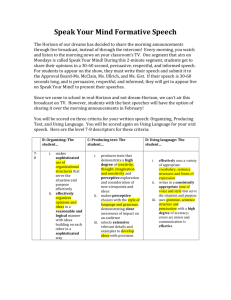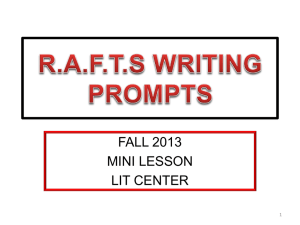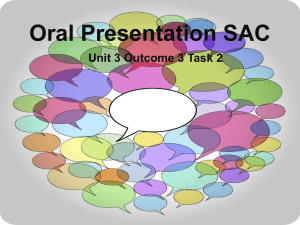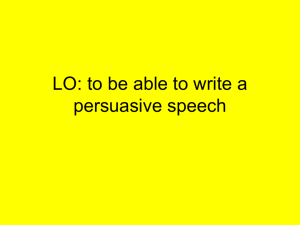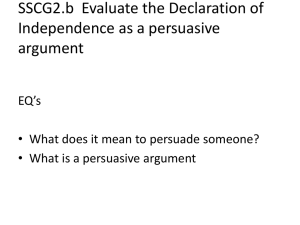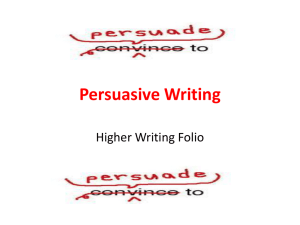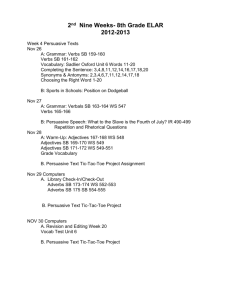Teaching the productive skills: speaking
advertisement
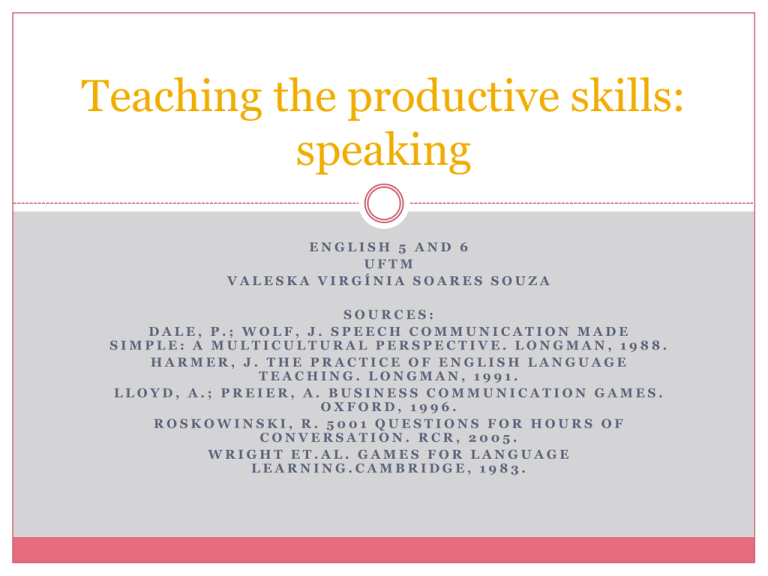
Teaching the productive skills: speaking ENGLISH 5 AND 6 UFTM VALESKA VIRGÍNIA SOARES SOUZA SOURCES: DALE, P.; WOLF, J. SPEECH COMMUNICATION MADE SIMPLE: A MULTICULTURAL PERSPECTIVE. LONGMAN, 1988. HARMER, J. THE PRACTICE OF ENGLISH LANGUAGE TEACHING. LONGMAN, 1991. LLOYD, A.; PREIER, A. BUSINESS COMMUNICATION GAMES. OXFORD, 1996. ROSKOWINSKI, R. 5001 QUESTIONS FOR HOURS OF CONVERSATION. RCR, 2005. WRIGHT ET.AL. GAMES FOR LANGUAGE LEARNING.CAMBRIDGE, 1983. INTRODUCTION Communication between humans is an extremely complex and ever-changing phenomenon, but there are certain generalisations that we can make about the majority of communicative events and these will have particular relevance for the learning and teaching of languages. When two people are engaged in talking to each other we can be fairly sure that the are doing so for good reasons: They want to say something. Speakers often make definite decisions to address other people, otherwise they would keep silent. They have some communicative purpose. They want something to happen as a result of what they say. What is important is the message they wish to convey and the effect they want it to have. They select from their language store. Speakers have an infinite capacity to create new sentences. In order to achieve this communicative purpose they will select the language they think is appropriate for this purpose. Warm-up Activities As language teachers, many of us start class with a warm-up activity. Why? Many reasons. It introduces the lesson topic. It gets everyone’s attention. It can get the class working together as a group. There may be more. Learning English is a skill. As such, it is more like music, physical education and other “learning by doing” classes at school than it is like history where you just need to master and apply facts. How do you start a music class? With a warm-up. What do you do before sports? Warm-up. I use those two examples (as opposed to other “learning by doing” classes like math or science) because of the kind of warm-up involved. They are often physical. In music, people do scales. In physical education, some kind of stretches. In English class? There are lots of options but the purpose of this handout is to share some ideas for physical warm-ups. I am not suggesting that warm-up activities that involve movement are the only good ones. They aren’t. But there are several reasons to make use of physical activities. Source: http://www.mgu.ac.jp/~ic/helgesen/physical/physical_-prehtml.htm ACTIVITY: TELEPHONE EXCHANGES Reaching a consensus The first type of activity designed to provoke spoken communication in the classroom is reaching a consensus. Consensus activities have been very successful in promoting free and spontaneous language use. Going to New York: In this activity students are told that they are going on holiday and have to decide what 10 objects to take with them. They will have to reach a consensus on these objects. Stage 1: All the students are asked to write down the ten items they would choose to have in their luggage if they were going to stay in New York for two weeks. Stage 2: When all the students have completed their lists, they are put into pairs. Each pair has to negotiate a new list of ten items. This will involve each member of the pair changing their original list to some extent. Stage 3: When the pairs have completed their lists, two pairs are joined to negotiate a new list, and this can go on... Stage 4: When the teacher thinks the activity has gone on for long enough, a feedback session is conducted with the whole class in which each group explains and justifies its choices. Discussions Many teachers can be heard complaining that their students ‘have nothing to say’: they complain, for example, that they have no opinions and are not prepared to discuss anything. Part of the problem is the way in which some teachers approach discussion as an activity. If students are asked to express themselves fluently on a difficult topic in front of their peers in a foreign language, they may find themselves reluctant to do so! Here are some hints about organizing discussions: Put students in groups first. This will allow them to give opinions in a less threatening environment than in front of the whole class. Give students a chance to prepare. Where a more formal discussion, such as a debate, is due to take place, students need a chance to prepare their opinions. Give students a task. They can be given a list of controversial statements about a topic and asked to score them from + to -. • ACTIVITY – DISCUSSION LINES Lessons from nothing ACTIONS BY ONE PERSON So often the present continuous is practised in the classroom by reference to actions which are seen. In this game, the learners close their eyes, listen and try to interpret what they hear. Ask everyone to close their eyes and put their heads on their arms to reduce the chance of them sneaking a look! Give a written sequence of actions to one learner to perform. Ask the learner to do the sequence of actions twice. During the first sequence, the class listen and say nothing. During the second sequence, you can ask questions. Walk across the room to the teacher’s desk Place your school material on it Walk towards the window Open and then close it Walk across the room Open the classroom door Go out and close the door Using the board: build a story (silent teacher) This activity does rather depend on your ability to draw quickly. The drawing does not need to be good! Essentially, you begin to draw a large picture on the board. From the moment you begin, invite description and interpretation of what you are doing. If you remain totally silent, the effect, though somewhat bizarre to begin with, can be impressive. The learners feel responsible for the story. You can mix your role: you can confirm a suggested interpretation as if the story already exists in your mind or you can accept another interpretation which will lead the story away from the one you had planned. When you and the class feel the story is complete, you can speak. Congratulate them. Then ask each student to reconstruct the story and to prepare to tell it to their neighbour. This will demonstrate that each person experienced the story differently. Questions for conversation Do you enjoy studying English? Why? What do you like most about studying it? What are some good ways to learn English? Do you read magazines or books in English? Which? When you watch a movie in English, how much do you understand? Which English is easier for you to understand, American or British? When you listen to music, do you understand the lyrics? • ACTIVITY: ASK A QUESTION CIRCLE – COLORS / IDIOM BOOK Communication games Communication games are based on the principles of information gap, in which one person has information the other doesn’t. Students are put into a situation in which they have to use all or any of the language they possess to complete a game-like task. Find the differences (or similarities): Students are put into pairs. In each pair, Student A is given a picture and Student B is given a picture which is very similar, but different in some vital aspects. They are told that they must not look at each other’s material, but that they must find out a certain number of differences between the two pictures through discussion only. Simulation and role-play The idea of a simulation is to create the pretence of a real-life situation in the classroom: students ‘simulate’ the real world. Thus we might ask them to pretend that they are at an airport, or we might organise them to together to plan an imaginary reunion. What we are trying to do – artificially of course – is to give students practice in real-world English. As for necessary characteristics, Jones (1982) says that there needs to be a ‘reality of function’ (students must accept the function; they must not think of themselves as language students, but as the people in the simulation). A simulated environment (we do not take the students to a real airport – that would no longer be a simulation, it would be the real thing!) and structure (there must be some structure to the simulation and essential facts must be provided). • BURNOUT ACTIVITY Speaking to persuade Persuasive speaking is all around us. Any speech is persuasive if its purpose is to convince others to change their feelings, beliefs, or behavior. A salesperson trying to convince someone to buy a product, a political leader trying to get someone to vote a certain way, and a teacher lecturing about why a history class should be required are all speaking to persuade. When do we make persuasive speeches? We make them all the time. When we ask a friend to lend us money, ask our teacher for a higher grade, try to convince a sibling to lose some weight, or try to persuade a parent to buy us something, our goal is to try to change or influence others. Preparing for the Persuasive Speech As with other kinds of speech, you build a persuasive speech step-by-step. The persuasive speech blueprint below will help you create persuasive presentation that are interesting and effective. The steps for preparing a persuasive speech are: 1. 2. 3. 4. 5. 6. Determining your specific purpose Choosing your topic Analyzing your audience Gathering information Preparing visual aids Organizing your speech Determining your specific purpose To change audience’s belief (that something is true or false), such as: a reported fact is either true or false something will or won’t happen an event was represented accurately or inaccurately To change audience’s opinion (about something’s value), as something is: good or bad Fair or unfair Helpful or not Important or unimportant Better or worse (than..) To change audience’s behavior, convince your listeners to either: do something they are not doing now stop some behavior they currently practice
